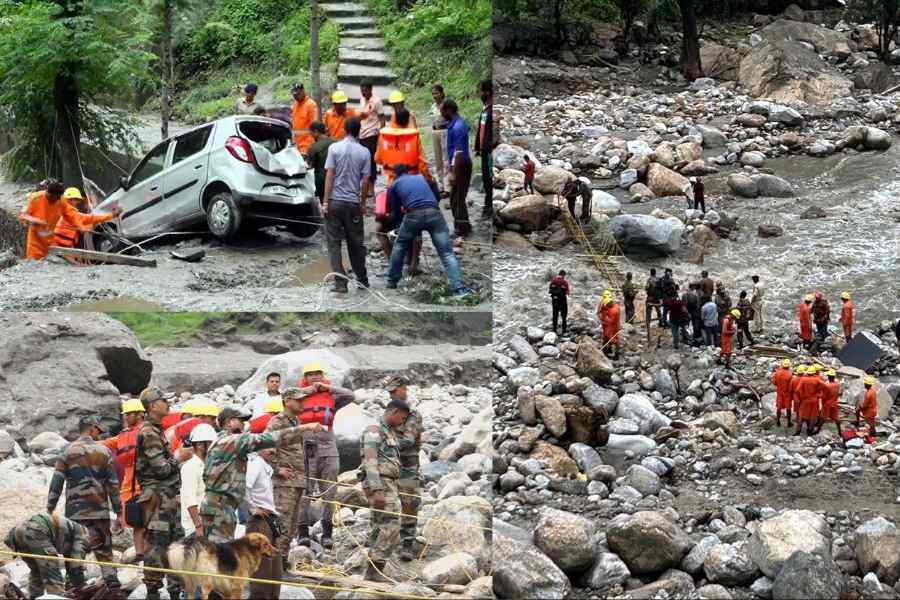Accurate, state-of-the-art weather forecasts aren’t enough. India needs to urgently establish early warning systems that take into account local terrain, population, and infrastructure for hyper-localised impact forecasts, experts have asserted amid evidence for rising counts of extreme rainfall events and flooding triggered by the phenomenon called flying rivers.
One study has established a three-fold rise in monsoon extremes between 1950 and 2023. Another study has found that seven of the 10 deadliest floods in India from 1985 to 2020 were linked to flying rivers. In the following interview, two climate researchers, Roxy Mathew Koll of the Indian Institute of Tropical Meteorology, Pune, and Vimal Mishra of the Indian Institute of Technology, Gandhinagar, spoke to The Telegraph about the emerging risks and need for adaptation.
Q: What are flying rivers?
Mishra: We call them atmospheric rivers. They are long and narrow bands of water vapour that form in the atmosphere from the evaporation of ocean water. The warm temperatures create moisture-laden pockets of air which get transported by winds across hundreds of kilometres across the oceans and onto land. The evidence indicates that the frequency and intensity of atmospheric rivers are increasing under global warming. More water evaporates and the atmosphere can store more moisture — there is both more supply and more storage.
Q: Are all extreme rainfall events triggered by flying rivers?
Mishra: Not all of them. Extreme rainfall events might be localised or widespread. Atmospheric rivers originate over the oceans and typically cover very large regions that stretch across hundreds of kilometres and they carry huge amounts of moisture. An extreme rain event resulting from an atmospheric river is likely to be spread out geographically and over time — it may rain nearly continuously for two or three days. One example of intense rainfall and flash floods from an atmospheric river is the 2013 floods in Uttarakhand. The atmospheric river delivered more than 400mm rainfall over the Uttarakhand region over a three-day period.
Q: How strong is the evidence for India’s rising counts of extreme weather events?
Koll: We have analysed the India Meteorological Department data from 1950 to 2023. A consistently increasing trend in extreme rainfall events is obvious through the entire period, whichever time slice you pick. During this period, we see a threefold rise in widespread monsoon extremes that have resulted in floods and loss of lives across the country. Our research also shows a 52 per cent increase (in the frequency) of Arabian Sea cyclones over the last four decades. This has put the west coast under unprecedented risk. We’re seeing a clear trend of rising heatwaves, floods, landslides, droughts, and cyclones. This is affecting food, water, and energy security — endangering lives and livelihoods. India has become a poster child for the adverse impacts of climate change.
Q: How can some of the adverse impacts of extreme weather events be mitigated?
Mishra: What is happening now is that our capacity to respond is being overwhelmed by the frequency of natural disasters. The rate at which natural disasters are striking us — whether floods or landslides — is much faster than our adaptation rate. We need to address this mismatch. For this, we need to prepare ourselves for what I would call cascading impact forecasts. For instance, we need forecasts telling us specifically where landslides will occur or which areas of a city will flood during heavy rains.
Koll: We have a state-of-the-art forecasting system in India. We can predict extreme weather conditions up to three days in advance, although accuracy of intensity and exact locations could be improved. But beyond forecasts, we need early warning systems that factor in local geography, demographics, and local infrastructure, with rapid communication and administrative action. This will require enhanced inter-ministerial and inter-departmental as well as Centre-state coordination which requires urgent streamlining.
India needs to urgently tailor adaptation plans and policies based on climate risks. This will require risk assessment and climate action plans at hyperlocal levels aimed at disaster-proofing every city and district. We need to disaster-proof India
at the district and panchayat levels. Something that requires strong political will, finance, scientific expertise, and interdepartmental cooperation. We also need policies that identify hazardous hotspots and advance plans to safeguard lives and livelihoods in those areas. Knee-jerk disaster management response to forecasts does not save lives all the time.











